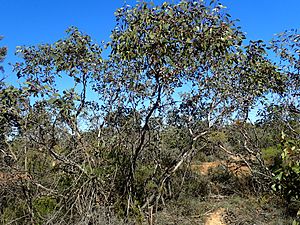Kessell's mallee facts for kids
Quick facts for kids Kessell's mallee |
|
|---|---|
 |
|
| Eucalyptus kessellii south of Ravensthorpe | |
| Scientific classification | |
| Genus: |
Eucalyptus
|
| Species: |
kessellii
|
Eucalyptus kessellii, commonly called Kessell's mallee, is a special type of mallee plant. This means it's a kind of Eucalyptus tree or shrub that usually has many stems growing from the ground. It is found only in a specific area along the south coast of Western Australia.
This plant has very hard, rough bark on the lower part of its trunk. Higher up, the bark is smooth and can be grey or brownish. Its adult leaves are shaped like spears or eggs. The flowers grow in groups of three or seven and are creamy white. After flowering, it produces unique, downturned, cone-shaped fruits.
Contents
What Kessell's Mallee Looks Like
Kessell's mallee usually grows as a large shrub, reaching about 10 meters (33 feet) tall. Sometimes, it can grow as a single-stemmed tree. It has a special woody swelling at its base called a lignotuber. This helps the plant regrow after a fire.
The bark on the lower part of the trunk is often hard, thin, and dark grey. On younger plants or higher up, the bark is smooth and can be grey, brownish, or even pink.
Young plants and new shoots (called coppice regrowth) have leaves that are egg-shaped or nearly round. These leaves are about 3 to 9 centimeters (1.2 to 3.5 inches) long and 4 to 9.5 centimeters (1.6 to 3.7 inches) wide.
Older, mature plants have dull, greyish-green leaves. These leaves are shaped like spears or eggs and are about 7 to 14.5 centimeters (2.8 to 5.7 inches) long and 2 to 4 centimeters (0.8 to 1.6 inches) wide. They grow on a stalk called a petiole, which is about 1.5 to 3.5 centimeters (0.6 to 1.4 inches) long.
The flower buds grow in groups of seven, or sometimes three, in the leaf corners. They are on a broad, flat, downturned stalk called a peduncle, which is 8 to 25 millimeters (0.3 to 1 inch) long. Each individual bud might be directly attached (called sessile) or on a short stalk called a pedicel, up to 10 millimeters (0.4 inches) long.
Mature buds are oval or diamond-shaped. They are about 14 to 23 millimeters (0.6 to 0.9 inches) long and 9 to 13 millimeters (0.4 to 0.5 inches) wide. Each bud has a cone-shaped or slightly beaked cap called an operculum.
Kessell's mallee flowers between June and September. Its flowers are a beautiful creamy white color. The fruit is a woody, cone-shaped or cup-shaped capsule. It is about 9 to 14 millimeters (0.4 to 0.6 inches) long and 11 to 18 millimeters (0.4 to 0.7 inches) wide. The fruit hangs downwards on a pedicel, and its seed compartments (called valves) stick out above the rim when the fruit is fresh.
How Kessell's Mallee Got Its Name
The scientific name for Kessell's mallee, Eucalyptus kessellii, was first officially described in 1925. This was done by two botanists, Joseph Maiden and William Blakely. They described it from a plant sample found near Salmon Gums. Their description was published in a scientific journal called Journal and Proceedings of the Royal Society of New South Wales.
The "kessellii" part of the name honors a person named Stephen Lackey Kessell.
In 1992, two other botanists, Ken Hill and Lawrie Johnson, described two different types (subspecies) of Kessell's mallee. These names are now accepted by the Australian Plant Census, which keeps track of plant names:
- Eucalyptus kessellii subsp. eugnosta: This subspecies has fruits that are smooth or have very small ridges, less than 1 millimeter high.
- Eucalyptus kessellii subsp. kessellii: This subspecies has fruits with clear ridges that are more than 1 millimeter high.
Where Kessell's Mallee Lives
Kessell's mallee grows in mallee shrubland. This is a type of bushland where many mallee plants grow. It prefers to grow in soil that is rich in calcium carbonate (like limestone) and is a type of loam.
The subspecies eugnosta is found in an area from near Ravensthorpe to near Condingup. It also grows as far north as Scaddan and Gibson.
The subspecies kessellii grows from the north-east of Salmon Gums to near Mount Ney and Mount Ridley.
Conservation Status
Both subspecies of Eucalyptus kessellii are considered "not threatened" by the Western Australian Government's Department of Parks and Wildlife. This means they are not currently at risk of disappearing.
Images for kids





